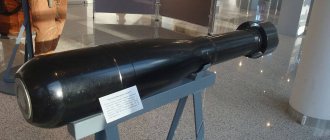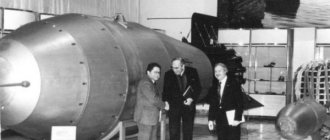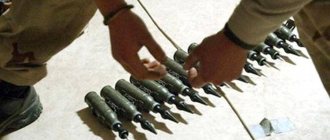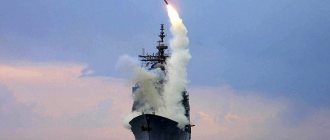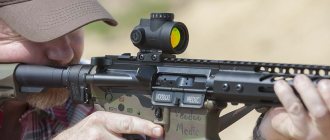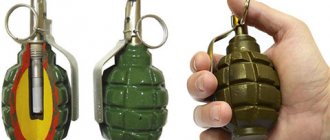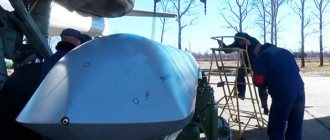Psychological aspect Ban on the use of phosphorus bombs How to protect yourself How to cope with the consequences
Video: phosphorus bomb
Many learned about phosphorus bombs from news reports when the latest sad events in Ukraine were described. There are several types of weapons, the main part of which is white phosphorus - a self-igniting substance that burns in air and, together with a number of incendiary substances, becomes a dangerous “filling” for ammunition.
Notes
- “ White phosphorus is poisonous…White phosphorus has been used for military purposes as a source of smoke and to fill
incidentiary shells and grenades
”Phosphorus (P) // The New Encyclopedia Britannica. 15th edition. Micropaedia. Vol.9. Chicago, 1994. pp.397-398 - Incendiary substances // Soviet military encyclopedia. / ed. N.V. Ogarkov. Volume 3. M., Military Publishing House, 1977. pp. 366-367
- Incendiary substances // Military encyclopedic dictionary. / ed. coll., ch. ed. S. F. Akhromeev. 2nd ed. M., Voenizdat, 1986. p.261
- R. A. Gulyansky, H. E. Kalvan, Yu. N. Kovalevsky, B. K. Mazanov. Protecting the population from modern weapons. Riga, Avots, 1989. pp.48-50
- Major D. Volk. Phosphorus ammunition // “Foreign Military Review”, No. 7 (808), July 2014. p.55
- Yu. G. Veremeev. Mines: yesterday, today, tomorrow. Minsk, “Modern School”, 2008. p.344
- I. D. Grabovoi, V. K. Kadyuk. Incendiary weapons and protection against them. M., Voenizdat, 1983. p.22
- I. D. Grabovoi, V. K. Kadyuk. Incendiary weapons and protection against them. M., Voenizdat, 1983. p.21
- I. D. Grabovoi, V. K. Kadyuk. Incendiary weapons and protection against them. M., Voenizdat, 1983. p.12
- A. N. Ardashev. Flamethrower and incendiary weapons: an illustrated guide. M., LLC publishing house "Astrel"; LLC publishing house "AST", 2001. pp. 79-80
- Phosphorus // Chemical encyclopedia (5 vols.) / editorial coll., ch. ed. N. S. Zefirov. volume 5. M., scientific publishing house "Big Russian Encyclopedia", 1998. p.144-147
- I. D. Grabovoi, V. K. Kadyuk. Incendiary weapons and protection against them. M., Voenizdat, 1983. p.3
- «White phosphorus is poisonous, in air at a temperature of approx. 40 °C self-ignites
»Phosphorus // Great Soviet Encyclopedia. / ed. A. M. Prokhorova. 3rd ed. volume 27. M., “Soviet Encyclopedia”, 1977. p.561-563
- «White P is highly toxic; hot P causes severe burns
"Phosphorus // Chemical encyclopedic dictionary / editorial coll., ch. ed. I. L. Knunyants. M., “Soviet Encyclopedia”, 1983. p.628-629
- «During the first (1914-18) and second (1939-45) world wars, white F. were equipped with incendiary bombs and artillery shells
»Phosphorus // Great Soviet Encyclopedia. / ed. coll., ch. ed. B. A. Vvedensky. 2nd ed. volume 45. M., State scientific publishing house "Big Soviet Encyclopedia", 1956. p.344-346
- Laws and customs of war // M. Yu. Tikhomirov, L. V. Tikhomirova. Legal encyclopedia. 6th ed., trans. and additional M., 2009. p.345
- The Convention on Certain Conventional Weapons. the United Nations Office at Geneva (UNOG). – “The Convention on Prohibitions or Restrictions on the Use of Certain Conventional Weapons Which May Be Deemed to Be Excessively Injurious or to Have Indiscriminate Effects as amended on December 21, 2001(CCW) is usually referred to as the Convention on Certain Conventional Weapons. It is also known as the Inhumane Weapons Convention." Retrieved October 14, 2014.
- Convention on Prohibitions or Restrictions on the Use of Certain Conventional Weapons Which May Be Deemed to Cause Excessive Injury or to Have Indiscriminate Effects (Russian)
. un.org/ru. “The Convention on Prohibitions or Restrictions on the Use of Certain Conventional Weapons That May Be Deemed to Cause Excessive Injury or to Have Indiscriminate Effects is often also referred to as the Convention on Certain Conventional Weapons or the Inhumane Weapons Convention (CCW).” Retrieved October 15, 2014.
- I. A. Khormach. Return to the world community. The struggle and cooperation of the Soviet state with the League of Nations in 1919-1934. Monograph. M., “Kuchkovo Pole”, 2011. p.420-469
- I. D. Grabovoi, V. K. Kadyuk. Incendiary weapons and protection against them. M., Voenizdat, 1983. pp.5-7
- A. N. Ardashev. Flamethrower and incendiary weapons: an illustrated guide. M., LLC publishing house "Astrel"; LLC publishing house "AST", 2001. p.143-145
- A. de Quesada, P. Jowett, R. Bujeiro. The Chaco War 1932-35. South America's greatest modern conflict. London, Osprey Publishing Ltd., 2011. page 8
- Yu. G. Veremeev. Mines: yesterday, today, tomorrow. Minsk, “Modern School”, 2008. p.232-233
- Volnov, L. L.
Lebanon: echo of aggression. – M.: Politizdat, 1984. – P. 52-54.
- High-quality black and white photographs of an unexploded artillery shell with clearly visible markings: The people cannot be defeated! Photo album / comp. V. F. Zharov. – M.: Planeta, 1983. – P. 24-25.
- They are waging a chemical war // Izvestia: newspaper. – No. 116 (20827). – April 25, 1984. – P. 4.
- Stroev, A. P.
Nicaraguan essays. Along the path of socio-economic revival. – M.: International Relations, 1989. – P. 74.
Corax in EVE Online – Caldari missile destroyer
How to celebrate autumn in your area
1.2. Brief characteristics of incendiary substances: napalm, pyrogel, thermite, white phosphorus
Incendiary mixtures based on petroleum products (napalm)
Incendiary mixtures based on petroleum products (napalm) can be unthickened or thickened (viscous). This is the most widespread type of incendiary mixtures with burn and incendiary effects. Unthickened incendiary mixtures are prepared from gasoline, diesel fuel or lubricating oils. Thickened mixtures are viscous, gelatinous substances consisting of gasoline or other liquid hydrocarbon fuel mixed in certain proportions with various thickeners (both flammable and non-flammable).
Metallized incendiary mixtures (pyrogels)
Metallized incendiary mixtures (pyrogels) consist of petroleum products with the addition of powdered or shavings of magnesium or aluminum, oxidizing agents, liquid asphalt and heavy oils. The introduction of combustible metals into the mixture increases the combustion temperature and gives these mixtures a burning ability.
Napalms and pyrogels have the following basic properties:
- adhere well to various surfaces of weapons, military equipment, uniforms and the human body;
- are easily flammable and difficult to remove and extinguish;
- when burning, they develop a temperature of 1000-1200ºС for napalms and 1600-1800°С for pyrgels.
Napalms burn due to oxygen in the air; combustion of pyrgels occurs both due to oxygen in the air and due to the oxidizing agent included in their composition (most often salts of nitric acid).
Napalms are used to equip tank, mechanized and backpack flamethrowers, aircraft bombs and tanks, as well as various types of fire mines. Pyrogels are used to equip incendiary aviation ammunition of small and medium caliber. Napalms and pyrogens are capable of causing severe burns to personnel, setting fire to equipment, and also creating fires in the area, in buildings and structures. Pyrogels, in addition, are capable of burning through thin sheets of steel and duralumin.
Termites and termite compounds
When thermites and thermite compositions burn, thermal energy is released as a result of the interaction of the oxides of one metal with another metal. The most widely used are iron-aluminum thermite compositions containing oxidizing agents and binding components. Thermites and thermite compounds, when burned, form liquid molten slag with a temperature of about 3000°C. The burning thermite mass is capable of melting elements of weapons and military equipment made of steel and various alloys. Thermite and thermite compositions burn without air access and are used to equip incendiary mines, shells, small-caliber bombs, hand-held incendiary grenades and bombs.
White phosphorus and plasticized white phosphorus
White phosphorus is a solid, poisonous, waxy substance that spontaneously ignites in air and burns, producing large amounts of acrid white smoke. The combustion temperature of phosphorus is 1200°C.
Plasticized white phosphorus is a mixture of white phosphorus with a viscous solution of synthetic rubber. Unlike ordinary phosphorus, it is more stable during storage; when ruptured, it is crushed into large, slowly burning pieces. Burning phosphorus causes severe, painful burns that take a long time to heal. It is used in artillery shells and mines, aircraft bombs, and hand grenades. As a rule, incendiary-smoke-producing ammunition is filled with white phosphorus and plasticized white phosphorus.
2.4. Concrete-piercing ammunition
The ammunition is designed to destroy high-strength reinforced concrete structures, as well as to destroy airfield runways. The ammunition body contains two charges - cumulative and high-explosive - and two detonators. When encountering an obstacle, an instantaneous detonator is triggered, which detonates the shaped charge. With some delay (after the ammunition passes through the ceiling), the second detonator is triggered, detonating the high-explosive charge, which causes the main destruction of the object.
There may not be a cumulative charge. In this case, the barrier is broken through due to the kinetic action of the projectile. The high-explosive charge is triggered with a delay, allowing the projectile to penetrate the barrier or enter its thickness.
An example of such ammunition is the BETAB-500ShP active-reactive concrete-piercing bomb, designed to destroy reinforced concrete shelters and runways. The basis was an ordinary high-explosive bomb. The body is made more durable with a thicker head. The bomb is equipped with a braking parachute and a jet accelerator. It is dropped in horizontal flight mode from heights of 50-100 m. After the braking parachute is activated, the accelerator is turned on, which provides the bomb with the energy necessary to break through the obstacle. The bomb first penetrates the barrier and then explodes. BETAB-500ShP can pierce ceilings up to 550 mm thick. In medium-density soil, it forms a funnel with a diameter of 4.5 m. When a bomb hits the runway, the concrete coating is destroyed over an area of up to 50 m2.
From the end of 1943, heavy assault self-propelled artillery guns ISU-152 “St. John’s wort” began to enter service with the Soviet Army. Operating in defense mainly from ambushes, the ISU-152 showed that there was no enemy equipment that they could not destroy. 152-mm armor-piercing shells destroyed the medium German tanks Pz Kpfw-III and Pz Kpfw-IV, the armor of the new “Tigers” and “Panthers” also could not do anything against these shells. Often, due to the lack of armor-piercing shells, high-explosive or concrete-piercing shells were fired at enemy tanks. The kinetic energy of the 152.4-mm projectile was so great that when it hit the turret, it destroyed the structural elements of the shoulder strap with a purely mechanical impact, displacing the turret several tens of centimeters from the axis of rotation. There were times when these towers literally flew in the air due to the subsequent detonation of the ammunition after being hit by a shell. Finally, the ISU-152 was the only Soviet combat vehicle capable of successfully resisting the formidable German self-propelled gun Ferdinand (Elephant).
| Rice. 2.5. Kinetic and cumulative concrete-piercing ammunition |
Inhumane weapons: what is white phosphorus and why is it still used?
On October 14, the Syrian Ministry of Foreign Affairs, in a message addressed to the UN Secretary General, condemned the use of white phosphorus ammunition by aircraft of the international coalition led by the United States and demanded an investigation. White phosphorus is one of the most inhumane weapons on Earth. Why it is dangerous and whether it is really prohibited, read on 42.TUT.BY.
Why is white phosphorus dangerous?
White phosphorus is an extremely toxic substance that has several unpleasant properties. The first is that when burned, it softens, stretches and sticks stably to any surface.
Phosphorus bomb explosion. Photo: zonwar.ru
The second one ignites spontaneously in air and burns on the surface of clothing, skin and in the wound. By the way, it will burn in the wound until it is removed or the substance burns completely. It happened that particles of a substance lodged deep under the skin ignited right under the scalpel as soon as they gained access to oxygen. Its combustion temperature is 1200 degrees Celsius.
Third, white phosphorus is well absorbed into the blood, after which it affects the kidneys, liver, and circulatory system. And the lethal dose for humans is only 0.05 - 0.15 grams.
Dangerous first aid
An unprepared person cannot provide assistance to a victim of white phosphorus; rather, he himself will receive burns from this toxic substance. Anyone who inhales white phosphorus vapor is practically doomed - damage to the upper respiratory tract occurs. In this case, a severe spasm often occurs, which leads to death.
An American Douglas A-1 Skyraider attack aircraft strikes Viet Cong positions with phosphorus ammunition. Photo: wikipedia.org
The use of shells containing white phosphorus leads to large casualties among civilians. After the ammunition ruptures, the fragments penetrate deeply into the body and it is often impossible to save the person.
Those affected by white phosphorus are characterized by “face-hands” syndrome, when a person tries to remove the burning mixture from the face with bare hands. As a result, the victim receives severe burns to the hands, which are accompanied by severe pain.
In what conflicts was it used?
White phosphorus has been widely used since World War I, where it was originally used in smoke grenades. For example, phosphorus ammunition was used by the Americans during the Vietnam and Korean wars, and by Russian troops in the first and second Chechen campaigns.
81 mm phosphorus mine. Photo: wikipedia.org
British soldiers made extensive use of phosphorus grenades during the Falklands conflict to destroy Argentine positions, during the Israel-Lebanon conflict and others.
There were also frequent cases when two warring sides used white phosphorus, as, for example, was the case in Afghanistan. White phosphorus ammunition was used by the United States and the Taliban.
Is white phosphorus banned?
Not really. In 1977, additional protocols were adopted to the Geneva Convention for the Protection of Victims of War of 1949, prohibiting the use of white phosphorus ammunition if civilians were targeted. The US refused to sign it.
Also, in accordance with the Third Protocol to the 1980 UN Convention on Certain Weapons, incendiary weapons should not be used against civilians, and, in addition, they cannot be used against military installations that are located in areas where the civilian population is concentrated.
In other cases, the use of such bombs and shells is not prohibited. For example, Israel appealed to this when it attacked Hezbollah militants during the conflict in Lebanon in 2006. According to the Israeli military, all targets were in open areas.
Phosphorus ammunition
The first mention of phosphorus ammunition dates back to the beginning of the 20th century - in 1916, grenades filled with white phosphorus appeared in England. During World War II, white phosphorus began to be used as one of the substances in the filling of incendiary bombs. In recent years, only the American army has actively used phosphorus weapons, in particular in Iraq during the bombing of Fallujah. Currently, phosphorus ammunition is understood as a type of incendiary or smoke ammunition filled with white phosphorus. There are several types of such weapons and ammunition, including aerial bombs, artillery shells, rockets (missiles), mortar shells, and hand grenades. Unpurified white phosphorus is commonly called "yellow phosphorus". It is a flammable crystalline substance from light yellow to dark brown in color, which does not dissolve in water, and in air easily oxidizes and spontaneously ignites. White phosphorus as a chemical compound is very toxic (causes damage to bones, bone marrow, necrosis of the jaws).
A phosphorus bomb spreads a flammable substance whose combustion temperature exceeds 1200 °C. It burns with a dazzling, bright green flame and emits thick white smoke.
Its distribution area can reach several hundred square meters. The combustion of the substance continues until the access of oxygen stops or all the phosphorus burns out. To extinguish phosphorus, use water in large quantities (to reduce the temperature of the fire and convert phosphorus into a solid state) or a solution of copper sulfate (copper sulfate), and after extinguishing the phosphorus, cover it with wet sand. To protect against spontaneous combustion, yellow phosphorus is stored and transported under a layer of water (calcium chloride solution).
The use of white phosphorus gives a complex effect - not only serious physical injuries and slow death, but also psychological shock. The lethal dose of white phosphorus for an adult is 0.05-0.1 g. According to researchers, a characteristic feature of the use of this weapon is the charring of organic tissues, and when inhaling the burning mixture, burning of the lungs. Treatment of wounds caused by such weapons requires appropriately trained medical personnel. Special literature notes that inexperienced and untrained doctors can also receive phosphorus wounds when working with affected personnel. The military use of ammunition containing white phosphorus against targets located in or near cities and other populated areas is prohibited under international agreements (Protocol III to the Convention on Certain Conventional Weapons).
From the history of the use of phosphorus bombs: 1916. In England, incendiary grenades filled with white phosphorus were supplied to arm troops. The Second World War. White phosphorus began to be used as one of the substances in the filling of incendiary bombs. In 1972, according to the conclusion of a special UN commission, incendiary weapons were conditionally classified as weapons of mass destruction. 1980 According to the UN Convention on Prohibitions or Restrictions on the Use of Certain Conventional Weapons Which May Be Deemed to Cause Excessive Injury or to Have Indiscriminate Effects, the use of incendiary weapons against civilians is prohibited, and the use of air-delivered incendiary weapons against military installations in areas concentration of civilian population.
In the 1980s, the Vietnamese People's Army used white phosphorus against Khmer Rouge guerrillas during the occupation of Kampuchea. 1982 155-mm artillery shells filled with white phosphorus were used by the Israeli army during the Lebanon War (in particular, during the siege of Beirut). April 1984. In the area of the port of Bluefields, two Nicaraguan Contra saboteurs were blown up while trying to plant mines filled with white phosphorus. June 1985. "Contra" passenger ship "Bluefields Express" and burned the ship with American phosphorus grenades.
1992 During the siege of Sarajevo, phosphorus shells were used by Bosnian Serb artillery. 2004 The Americans dropped bombs filled with this substance on Fallujah (Iraq). In 2006, during the Second Lebanon War, artillery shells containing white phosphorus were used by the Israeli army. year 2009. During Operation Cast Lead in the Gaza Strip, the Israeli army used smoke munitions containing white phosphorus. year 2014. Semyonovka. The command of the anti-terrorist operation is committing war crimes against the civilian population of south-eastern Ukraine.
Video: Phosphorus bomb explosion
Performance characteristics
Let's consider some parameters of various “smoke” ammunition in service with the United States and Russia.
| 60 mm mine M722A1 | 81 mm M375A3 mine | 155 mm M110 projectile | 82 mm mine 53-D832 | 120 mm mine 53-D-843 | 122 mm 3D4 projectile | |
| Total weight, kg | 1,72 | 4,24 | 44,63 | 3,46 | 16,5 | 21,7 |
| Charge weight, kg | 0,35 | 0,7 | 7,08 | 0,4 | 1,9 | – |
It is worth noting that in Russia the VG-40-MD round was created for 40 mm under-barrel grenade launchers. The substance with which it is equipped is not directly named, but the ability to simultaneously create a “smoke screen and fires” makes one think of white phosphorus.
There is also a “smoke” version of the Shmel jet flamethrower - RPO-D. As stated, it not only puts up a smoke screen, but also creates “fires” and “unbearable conditions for manpower.” The composition of the smoke-forming substance is also not specified.
The caution is understandable
In Bulgaria, RSMK-7MA smoke shot is produced for RPG-7 type grenade launchers, but it is loaded with red phosphorus. They are also used to equip Bulgarian RLV-SMK-4 ammunition for NATO-standard under-barrel grenade launchers.
Now the desire to use effective weapons was limited by the risk of compromising oneself and being harshly condemned by the “international community.”
At the same time, we must remember that if soldiers are ready to kill and torture civilians, they can cope without “lighters.” And declarations and conventions are good as long as both parties are willing to adhere to their terms, or at least fear responsibility.
In what conflicts was it used?
White phosphorus has been widely used since World War I, where it was originally used in smoke grenades. For example, phosphorus ammunition was used by the Americans during the Vietnam and Korean wars, and by Russian troops in the first and second Chechen campaigns.
81 mm phosphorus mine. Photo: wikipedia.org
British soldiers made extensive use of phosphorus grenades during the Falklands conflict to destroy Argentine positions, during the Israel-Lebanon conflict and others.
There were also frequent cases when two warring sides used white phosphorus, as, for example, was the case in Afghanistan. White phosphorus ammunition was used by the United States and the Taliban.
International agreements governing the use of phosphorus munitions
The development, testing, transportation, trade, use and disposal of phosphorus ammunition are carried out taking into account a number of international agreements and treaties, including:
At the international level, attempts to limit the use of chemical and incendiary weapons during wars and military conflicts were made at the turn of the 1920s-1930s during the League of Nations Conference on the Reduction and Limitation of Arms. The intention was recorded in the text of the conference resolution, developed on July 9, 1932 and adopted on July 23, 1932. However, the deterioration of the international situation in the mid-1930s led to the termination of the conference in January 1936.
Ban on the use of phosphorus bombs
Currently, phosphorus bombs and other weapons containing phosphorus are prohibited from being used according to international agreements of 1868, 1949 and 1980. Despite numerous attempts to completely ban the use of such weapons, the agreements were constantly violated.
During the First and Second World Wars, bombs and hand grenades filled with white phosphorus were used by the Irish, Germans, British, Americans and Koreans. In addition, phosphorus ammunition has been used in our time, during the war in Iraq, as well as in the Gaza Strip. According to some reports, this type of weapon was also used in Ukraine in 2014, but its use was not confirmed by physical evidence - victims with characteristic burns, numerous fires, and so on.
2.5. Volumetric explosion ammunition
Designed to destroy enemy personnel, structures and equipment with a shock wave and fire. The energy source is a mixture of methylacetin, propadeine and propane with the addition of butane or a mixture based on propylene oxide (ethylene) and various types of liquid fuel.
The principle of operation of such ammunition is as follows: liquid fuel with a high calorific value (ethylene oxide, diborane, acetic acid peroxide, propyl nitrate), placed in a special shell, during an explosion splashes, evaporates and mixes with oxygen in the air, forming a spherical cloud of fuel-air mixture with a radius of about 15 m and a layer thickness of 2-3 m. The resulting mixture is detonated in several places with special detonators. In the detonation zone, a temperature of 2500-3000°C develops in a few tens of microseconds. At the moment of the explosion, a relative void is formed from the fuel-air mixture inside the shell - a lifeless space the size of a football field (this is why volumetric detonating ammunition is called “vacuum bombs”).
| Rice. 2.6. Use of volumetric explosion ammunition |
The main damaging factor of volumetric explosion ammunition is the shock wave. At the same time, the air temperature rises sharply, creating a vast area of the atmosphere depleted of oxygen and poisoned by combustion products.
In terms of their power, volumetric explosion ammunition occupies an intermediate position between nuclear and conventional (high-explosive) ammunition. In terms of its destructive ability, such ammunition can be comparable to tactical nuclear weapons. Excess pressure in the shock wave front of a volumetric explosion ammunition, even at a distance of 100 m from the center of the explosion, can reach 100 kPa (1 kgf/cm²).
Volumetric explosion bombs were tested by the Americans back in 1969 in Vietnam.
Volumetric explosion ammunition was repeatedly used in various wars of the 1980-90s. So on August 6, 1982, during the war in Lebanon, an Israeli plane dropped such a bomb (American made) on an eight-story residential building. The explosion occurred in the immediate vicinity of the building at the 1-2 floor level. The building was completely destroyed. About 300 people died (mostly not in the building, but those close to the explosion site).
In August 1999, during the period of Chechnya’s aggression against Dagestan, a large-caliber volumetric explosion bomb was dropped on the Dagestan village of Tando, where a significant number of Chechen militants had accumulated. The invaders suffered huge losses. In the following days, the mere appearance of a single (precisely single) Su-25 attack aircraft over any populated area forced the militants to hastily leave the village. Even the term “Tando effect” appeared.
Since the fuel-air mixture of volumetric explosion ammunition spreads easily and is capable of penetrating into unsealed rooms, as well as forming in folds of the terrain, the simplest protective structures cannot save them. Protection of people is ensured only by shelter in protective structures. Shelters must operate in complete isolation mode.
The shock wave resulting from the explosion causes injuries in people such as cerebral contusion, multiple internal bleeding due to rupture of the connective tissues of internal organs (liver, spleen), and rupture of the eardrums.
The high lethality, as well as the ineffectiveness of existing protection measures against volumetric explosion munitions, has led the United Nations to classify such weapons as an inhumane means of warfare that causes excessive human suffering. At a meeting of the Emergency Committee on Conventional Arms in Geneva, a document was adopted in which such ammunition was recognized as a type of weapon requiring prohibition by the international community.
Why is white phosphorus dangerous?
White phosphorus is an extremely toxic substance that has several unpleasant properties. The first is that when burned, it softens, stretches and sticks stably to any surface.
Phosphorus bomb explosion. Photo: zonwar.ru
The second one ignites spontaneously in air and burns on the surface of clothing, skin and in the wound. By the way, it will burn in the wound until it is removed or the substance burns completely. It happened that particles of a substance lodged deep under the skin ignited right under the scalpel as soon as they gained access to oxygen. Its combustion temperature is 1200 degrees Celsius.
Third, white phosphorus is well absorbed into the blood, after which it affects the kidneys, liver, and circulatory system. And the lethal dose for humans is only 0.05 - 0.15 grams.
Types of ammunition with phosphorus
All phosphorus ammunition can be divided into groups:
hand grenades; air bombs; rockets and missiles; mortar mines; artillery shells; air tanks
Under normal conditions, white phosphorus can be stored in stock for a long time without any reaction, however, certain conditions must be observed, the main one of which is that the air temperature should not rise above 34-40 degrees.
story
A member of the US Air Force inspects a 2.75-inch white phosphorus missile marking at Osan Air Base, South Korea in 1996
White phosphorus is believed to have been first used by Fenian arsonists in the 19th century, in the form of a solution in carbon disulfide. When the carbon disulfide was evaporated, the phosphorus would ignite. This mixture was known as "Fenian fire".
In 1916, during the intense struggle for conscription for the First World War, 12 members of the Industrial Workers of the World, a union of workers distinguished from conscription, were arrested in Sydney, Australia and convicted of using or conspiring to use incendiary materials, including including phosphorus. It is believed that eight or nine people from this group, known as the Sydney Twelve, were rounded up by police. Most of them were released in 1920 after request.
In what conflicts was it used?
White phosphorus has been widely used since World War I, where it was originally used in smoke grenades. For example, phosphorus ammunition was used by the Americans during the Vietnam and Korean wars, and by Russian troops in the first and second Chechen campaigns.
81 mm phosphorus mine. Photo: wikipedia.org
British soldiers made extensive use of phosphorus grenades during the Falklands conflict to destroy Argentine positions, during the Israel-Lebanon conflict and others.
There were also frequent cases when two warring sides used white phosphorus, as, for example, was the case in Afghanistan. White phosphorus ammunition was used by the United States and the Taliban.
How to deal with the consequences
Before taking actions aimed at saving a person, it is necessary to make sure that phosphorus bombs and the substances they contain are really the cause. Such burns have a specific smell of garlic, the skin around them smokes and chars.
First of all, an aseptic bandage is applied to the extinguished burn to prevent inflammation and infection. Next, all measures are taken to prevent painful shock with the subsequent evacuation of the person from the affected area. During the cold season, it is not recommended to remove the victim’s clothing so as not to increase the shock.
The use of any medications without a preliminary analysis of a person’s condition is permissible only if the doctor knows for sure that the medicine is more likely to help than harm. However, experts strongly recommend not to provide assistance to the victim if the person does not know what to do with such injuries.
Video: phosphorus bomb
Used for combat operations, ammunition was required that could destroy enemy ground forces over a large area. Incendiary bombs appeared on the eve of the First World War. These were primitive devices consisting of a container with kerosene and an inertial fuse, the basis for which was an ordinary rifle cartridge.
In the 1930s, so-called phosphorus balloons were used for bombing. They were filled with yellow phosphorus in the form of granules measuring 15-20 mm. When such a ball was dropped, it was set on fire, and closer to the ground, the burning particles of phosphorus, having scorched the shell, scattered, covering a huge area with fiery rain. The method of spraying ignited granules from special aircraft tanks at low altitude was also used.
During World War II, humanity first learned what a phosphorus bomb is in the form in which it exists today. It was a container filled with phosphorus balls weighing from 100 to 300 g, with a total weight of up to one ton. Such ammunition was dropped from a height of about 2 km and exploded 300 m from the ground. Nowadays, incendiary shells based on phosphorus in the strongest armies of the world occupy a significant part of the total ammunition used for bombing.
